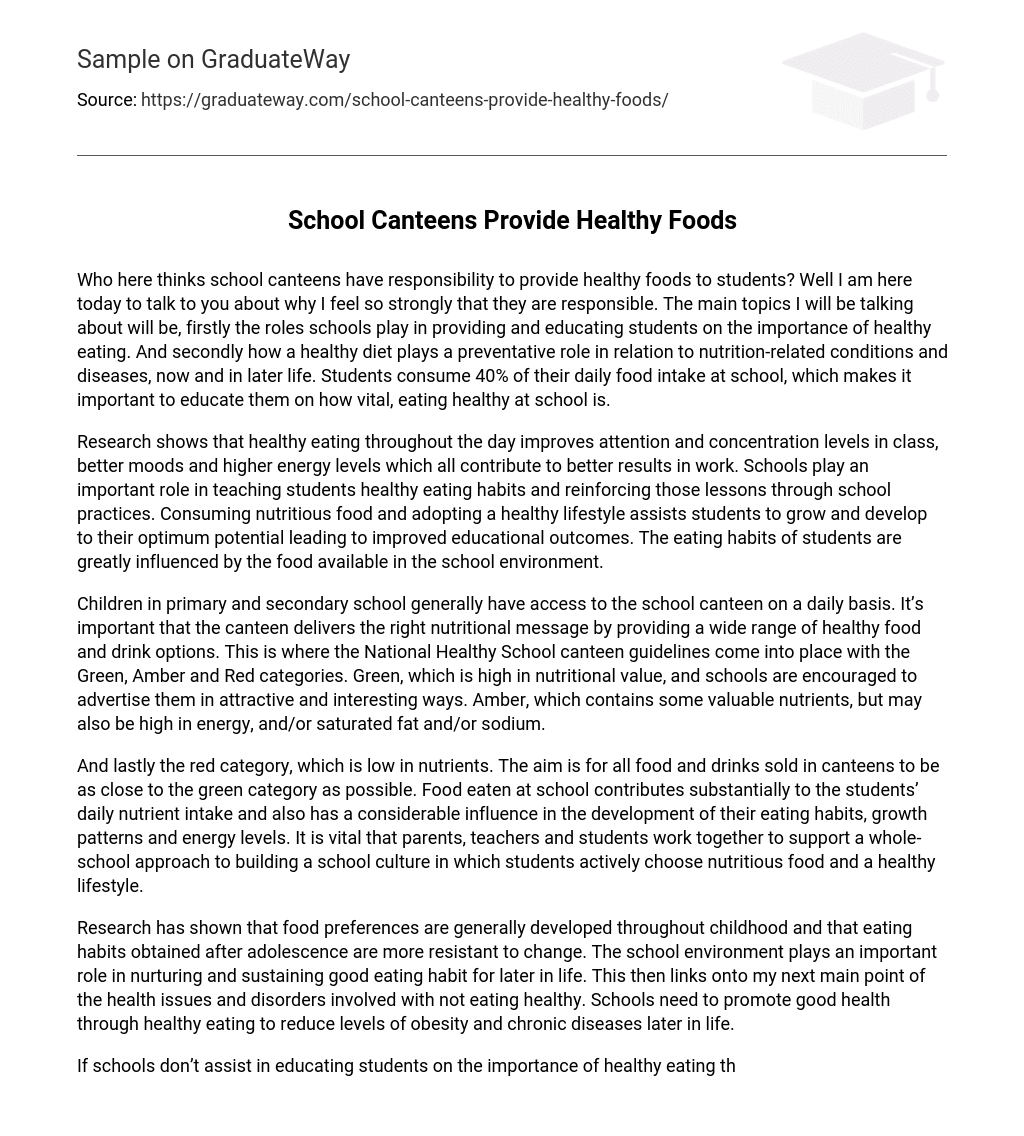I believe that school canteens should be required to provide students with healthy meals. This is important for two reasons. First, schools have a responsibility to teach and promote the importance of eating well. Second, a balanced diet helps prevent nutrition-related illnesses and diseases now and in the future. Since students consume 40% of their daily food at school, it is crucial to educate them about the value of eating nutritious meals while they are there.
Studies have shown that eating nutritious food throughout the day can improve focus, concentration, mood, and energy levels in school, leading to better academic performance. Schools play a vital role in teaching students about healthy eating habits and reinforcing them through their practices. By offering healthy food choices and promoting a wholesome lifestyle, schools can help students reach their full potential and achieve better educational outcomes. The variety of food options available at schools significantly influences students’ dietary preferences.
Children in primary and secondary school typically have daily access to the school canteen. It is crucial to promote a healthy message by offering a variety of healthy food and drink options. The National Healthy School canteen guidelines play a vital role in this effort, categorizing items into Green, Amber, and Red categories. Green items are highly nutritious and should be presented attractively to encourage consumption. Amber items contain valuable nutrients but may also have high levels of energy, saturated fat, and/or sodium.
Finally, the red category of food signifies items with low nutrient content. The objective is to ensure that all food and beverages provided in school cafeterias resemble those in the green category as closely as possible. The kind of food students consume at school significantly affects their daily nutrient intake, eating habits, growth patterns, and energy levels. It is crucial for parents, teachers, and students to collaborate in order to foster a comprehensive approach towards establishing a school environment where students actively opt for nutritious food and embrace a healthy lifestyle.
Research indicates that food preferences are often established in childhood, making it challenging to alter eating habits later in life. Consequently, schools play a vital role in establishing an atmosphere that fosters and sustains healthy eating behaviors for long-term health advantages. Furthermore, inadequate consumption of nutritious food can contribute to a range of health issues and disorders. Therefore, it is imperative for schools to prioritize the promotion of good health by encouraging healthy eating practices as a means to reduce the risk of obesity and chronic diseases in the future.
If schools fail to teach students about the significance of healthy eating, it is improbable that they will cultivate favorable eating behaviors, which may persist into adulthood. This could result in numerous health problems such as obesity, psychosocial issues, osteoporosis, cardiovascular disease, asthma, sleep apnea, and type 2 diabetes. These health implications are directly associated with childhood obesity. To tackle this problem, Healthy Kids Association – a charitable organization committed to promoting health – seeks to inspire and encourage children to opt for healthier food options.
The reduction in childhood overweight and obesity, as well as the prevalence of diet-related illnesses among children, will be achieved. According to statistics from the better health channel, the number of 7-15 year olds who are overweight nearly doubled between 1985 and 1995. Moreover, there has been a more than triple increase in the number of obese children. If this pattern continues, it is predicted that by 2020, 65 percent of young Australians will be classified as overweight or obese. To provide a visual representation of this projection, out of a class of 25 students, approximately 16 would fall into the categories of being overweight or obese. Statistics indicate that around half (43-65%) of obese children will ultimately develop obesity during their adult years.
Considering current trends, it is conceivable to anticipate a decrease in life expectancy for future generations compared to prior ones due to obesity. Consequently, I firmly endorse the notion of schools instructing and aiding students in adopting healthy eating habits, as well as preventing diseases and disorders for their future welfare. Ultimately, I profoundly believe that schools should provide nourishing and wholesome food choices in their cafeterias for the improvement of their students.





